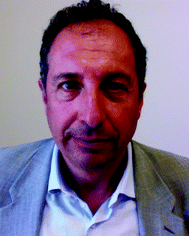Nanomaterials properties tuned by their environment: integrating supramolecular concepts into sensing devices
Paolo
Samorì
 *a and
Fabio
Biscarini
*a and
Fabio
Biscarini
 *b
*b
aUniversity of Strasbourg, Institut de Science et d'Ingénierie Supramoléculaires, 8 allée Gaspard, Monge, Strasbourg 67000, France. E-mail: samori@unistra.fr
bUniversity of Modena and Reggio Emilia, Department of Life Sciences, Via G. Campi 103, Modena I-41125, Italy. E-mail: fabio.biscarini@unimore.it
Self-organization and self-assembly have enabled the development of hierarchically-organized (multi)functional materials through the subtle control of adaptive interactions between suitably designed building blocks. The use of non-covalent interactions to construct sophisticated supramolecular architectures makes it possible to transduce the modifications of their environment into precise modulation of their self-assembly behavior. The changes in properties upon small environmental variations can be enhanced or amplified by integrating engineered assemblies into devices. To cast an example, once the supramolecular interactions between a designed receptor and an analyte (for instance, a small molecule or an ion) present in the environment are efficiently coupled to the active area of a device, then extremely sensitive and selective sensors can be fabricated. The transducer response can be either a change in mass, or optical properties (e.g. a modification in absorbance and/or fluorescence intensity), or a variation of parameters in electric characteristics (like a change in capacitance, transconductance, or threshold voltage).
Supramolecular recognition can, therefore, be the key concept for the design and making of the next generation of sensors exhibiting detection limits down to sub-ppb level, with fast response speed combined with unprecedented selectivity. These characteristics are the result of optimally designed non-covalent interactions through the integration of receptor groups possessing ad hoc characteristics by design including size, geometry, dipole and quadrupole moments, surface charges, and H- or halogen bonds. Since specific sensing is triggered by molecular recognition, the sensitivity can be harnessed by using low-dimensional structures exhibiting a highly accessible surface area, decorated with receptors. These concepts can lead us to devise the last generation of ultrasensitive and ultraselective sensors for food safety, environmental and biohealth monitoring, as well as for chemical- and biodefense.
This special issue focusses on the development of novel materials and their integration in sensing devices to detect the presence of ions, heavy metals, small molecules and biomolecules. Such environmental monitoring, which is also relevant for defense, security and safety applications, will unquestionably contribute to the improvement of people's quality of life and will offer solutions even to some key biomedical questions such as early diagnostics and continuous monitoring of diseases.
In this context, metal–organic frameworks (MOFs), when suitably engineered, can operate as highly sensitive and selective sensors. Shustova and co-workers (DOI: 10.1039/C7CS00861A) describe the possibility of using optical responses by taking full advantage of MOFs’ light-harvesting ability, thereby opening intriguing perspectives in photocatalysis; Li and collaborators (DOI: 10.1039/C7CS00885F) discuss the tailoring of such unique porous materials in order to efficiently capture toxic and hazardous gases and vapours.
Another family of materials particularly apt for sensing is that of 2D materials, as these nanosystems feature a highest surface-to-volume ratio and exceptional opto-electronic properties which are highly sensitive to changes in the environment. Samorì and co-workers (DOI: 10.1039/C8CS00417J) show that surface functionalization of graphene and molybdenum dichalcogenides with receptors of specific analytes makes possible the development of highly sensitive and selective sensors for the detection of gases, ions and small biomolecules.
The quantitative identification of biomarkers is key for the early diagnosis of diseases. A powerful method, which is reviewed by Xu, Kuang and co-workers (DOI: 10.1039/C7CS00894E), consists of the in vitro and in vivo use of the plasmonic effect in functionalized metal nanoparticles.
Towards the monitoring of the health of the world's population, Merkoçi and Quesada-González (DOI: 10.1039/C7CS00837F) discuss the use of different nanomaterials towards applications in point-of-care (PoC) diagnostics, a strategy that holds great potential for the development of miniaturized devices.
A novel approach towards biosensing, described by Lanzani, Di Maria and co-workers (DOI: 10.1039/C7CS00860K), relies on the development of artificial light actuators based on (in)organic semiconductors to transduce a light signal into a signal which affects biological activities in living systems, to ultimately control neural paths and other vital functions.
Finally, the medical evaluation of potential diseases in a non-invasive manner has paramount importance for early diagnosis. Haick and collaborators (DOI: 10.1039/C8CS00317C) describe how this can be accomplished via the analysis of volatile organic compounds (VOC) exhaled in breath, in combination with the analysis of human bodily fluids.
Chemical sensing is increasingly becoming less heuristic and more based on solid physico-chemical grounds. The chemistry approach to sensing is a fast expanding field of science which can take great advantage in the years to come from the rational design of functional low dimensional nanostructures whose properties are extremely sensitive to changes in the environment, in combination with the coupling to supramolecular receptors which are designed and synthesized from molecular biology or other emerging biotechnologies. We believe that this special issue will provide the readers with clear evidence and stimulating examples of the breadth of this field and possibly convey the enthusiasm of those scientists involved in this research. We are grateful to all of them for their effort in highlighting the fundamentals, the application and in several instances also the hurdles, subtleties and burning questions of the multidisciplinary field of chemical sensing.
| This journal is © The Royal Society of Chemistry 2018 |


